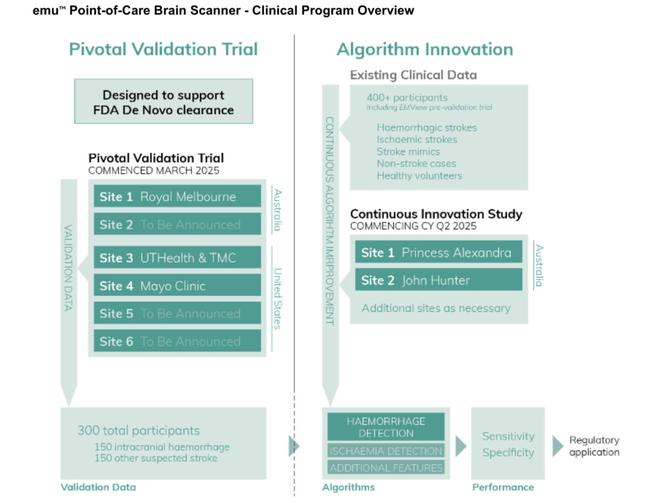EMVision advances its AI-driven stroke diagnostics
EMVision is advancing its AI-driven stroke diagnostics with promising new data showing enhanced performance of its ‘ischemia or not’ algorithm.

Stockhead
Don't miss out on the headlines from Stockhead. Followed categories will be added to My News.
EMVision Medical Devices advances its AI-driven stroke diagnostics
Promising new data shows enhanced performance of ‘ischemia or not’ algorithm
Data being presented at 11th European Stroke Organisation Conference
Special Report: EMVision Medical Devices is advancing its AI-driven stroke diagnostics with promising new data showing enhanced performance of its ‘ischemia or not’ algorithm.
EMVision Medical Devices (ASX:EMV) said the promising updated data is being presented at the 11th European Stroke Organisation Conference (ESOC 2025) in Helsinki, Finland, from 21-23 May.
The neurodiagnostics medical devices company previously reported that the AI-based ‘ischemia or not’ diagnostic algorithm achieved a sensitivity of 85% and specificity of 78% in the EMView pre-validation trial.
Sensitivity is the ability of the device to diagnose a disease, while specificity is the ability to rule out false positives.
The study was conducted at Liverpool Hospital in Sydney, The Royal Melbourne Hospital, and Princess Alexandra Hospital in Brisbane.
The algorithm was initially trained on more than 240 patient cases enrolled in the study.
Following training, it was tested on an unseen dataset that had been isolated and not used during the training phase.
EMVision said as part of ongoing innovation, the AI-powered ‘ischemia or not’ diagnostic algorithm has since been re-trained using cleaned training data and re-evaluated.
‘Ischemia or not’ refers to distinguishing between blockages – the more common ischemic strokes – and bleeds (haemorrhagic strokes).
In the updated dataset, the algorithm’s performance has improved as follows:

Source: EMVision
EMVision model shows promising detection
In a limited sensitivity analysis of 20 ischemic test cases, EMVision said the emu RF-based model missed only one case, compared to nine missed using first-line Non-Contrast Computed Tomography (NCCT).
EMVision said notably, three of the cases were also not identified using Computed Tomography Perfusion (CTP) or Computed Tomography Angiography (CTA).
They were only confirmed on follow-up MRI diffusion-weighted imaging (MR DWI) conducted 48 hours later.

Source: EMVision
Pivotal trial to validate algorithm performance
EMVision said whilst encouraging, due to the design of the study and limited sample size, the data does not yet allow statistically significant or generalisability conclusions to be drawn on the performance of the updated ‘ischemia or not’ AI-powered model.
Generalisability is the degree to which the results of a study can be applied to other situations.
The company said the recently started pivotal trial of its emu bedside brain scanner to diagnose stroke to support US Food and Drug Administration (FDA) de novo (new device) clearance was also designed to validate algorithm performance.
EMVision said it was implementing a cost-effective strategy for continued device innovation and enhancement during the pivotal trial.
Additional patients will be scanned at multiple sites in Australia outside of the pivotal trial, including the Princess Alexandra Hospital and John Hunter Hospital in Newcastle.
The company said the study data would be used to progress the development of additional device features, scale the training library for EMVision’s diagnostic AI algorithms – including ongoing ‘ischemia or not’ detection and classification development.
The data – which is separate to, and isolated from, the pivotal trial dataset – would also be used to potentially extend indications by the enrolment of patients with traumatic brain injury.
EMVision observed meaningful performance increases in the sensitivity/specificity of its diagnostic AI algorithms during the previous EMView pre-validation study when additional training data was used.

Source: EMVision
Importance of knowing ‘ischemia or not’
EMVision’s ‘ischemia or not’ AI-driven algorithm could play an important role in the future of prompt stroke detection and treatment.
Prompt and accurate stroke detection pre-hospital or in remote areas can accelerate treatment by ensuring that patients are directed to the most appropriate centre (e.g., stroke centre vs standard hospital) and the ED teams are prepared for their arrival, thus avoiding delays from unnecessary transfers or care coordination. In a comprehensive stroke centre, confidence in an ischaemic stroke diagnosis could enable direct transfer to an angiogram suite for intervention initiation, thus cutting down door-to-surgery times.
About half of suspected stroke cases aren’t stroke at all, and are instead ‘stroke mimics’ which often don’t require the same urgent care. Identification of true stroke cases ensures that hospital resources are put to best use by avoiding unnecessary imaging expenses, or by allowing regional hospitals to treat less critical patients rather than undertaking expensive transfers where they may not be necessary.
Furthermore, when it comes to treating stroke speed is crucial, treatment in the first 60 minutes after a stroke – known as ‘the golden hour’ – can heavily influence the likelihood of positive outcomes.
This article does not constitute financial product advice. You should consider obtaining independent advice before making any financial decisions.
Originally published as EMVision advances its AI-driven stroke diagnostics


